Jason V. Brock's Blog
August 18, 2022
Watch Cardinal Sin: Masters of the Genre – Logan’s Run / William F. Nolan Memorial
August 17, 2022
Chicon 8 Programming Schedule Announced
July 3, 2022
Rob Zombie: “Corpses, Rejects, Afterlives: Welcome to Zombieland” by Jason V Brock
Chicon 8: the 80th World Science Fiction Convention
Attending San Diego Comic Con 2022
September 30, 2021
One Week ‘Til World Horror Convention 2012
There's only one more week until World Horror Convention 2012 in Salt Lake City, Utah happens. I'm very much looking forward to this, and have already been told to get ready to sign some books.
A few weeks ago I finished Empire of Salt by Weston Ochse. It's a zombie novel that takes place in an area called the Salton Sea. Even though there were several typos in the beginning quarter of the story that threw me off, I continued to read, and have to say that I enjoyed it overall. The teenage, female protagonist was easy to relate to, as were most of the characters in the story. I believe the ending was left the way it was to make way for a sequel.
This past week I finished The Devil's Coattails anthology edited by Jason V. Brock and William F. Nolan. I have to say that I enjoyed this book and its stories very much. Not all of it was straight up horror, and every story had a nice literary bent that I really enjoyed reading. I highly recommend this book, and the artwork and hardcover book itself are exquisite.
Connected with the World Horror Convention this year is the Bram Stoker Awards Banquet. I have tickets to attend this. Last year it was in Long Island, New York and I had a great time. It's an opportunity to see all of the horror peeps dressed up. Which brings me to my next discussion. What to do if you had a dress you were planning to wear, but have gained some weight since then.
I generally run between a size 10 and a 12. So throughout the year, I purchase dresses in both of these sizes. My two favorite gown/dress designers are David Meister and Tadashi Shoji. Their dresses are generous and can usually "stretch" if need be. If I order a 10 I'm usually safe, and same way with a 12. The ruching techniques they use really give you a lot of flexibility. For the Stoker Banquet I am planning to wear a navy blue Tadashi Shoji dress with beadwork in the midsection. My shoes are navy blue Kate Spades with a black, sequined bow in the back which makes it easier to wear with sheer, black stockings. I just have to remember to walk slow and "dainty." During the day, I will be wearing cowboy boots, so the transition will take a little practice while I'm getting dressed.
I wish all of the Bram Stoker finalists the best of luck, and I can't wait to post all of the winners!
MADNESS! Roger Corman Intrudes on ANTHOLOGY FILM ARCHIVES
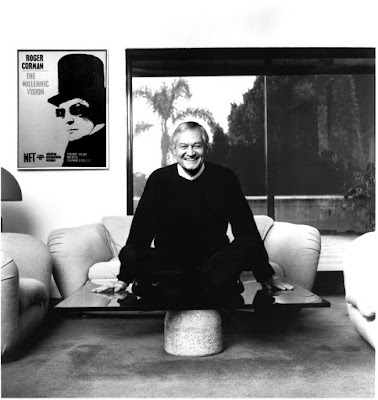
You’ve really got to hand it to Anthology Film Archives on this one – they’re the only ones who are crazy enough and cool enough to host this mammoth thirteen-film Roger Corman retrospective, easily one of the best NYC film programs all year. One of my favorite NY theatres, Anthology is an actual film archive as well as regularly operating theatre. Their film selection leans mostly toward the experimental and avant-garde (it was founded by some of the field’s heavies) but they’re also relentless when it comes to those who produce independent films outside of the art community, even when they may be as bent as the likes of outsider mavericks like Jim Van Bebber (DEADBEAT AT DAWN, THE MANSON FAMILY) or in this case, “indie”-before-there-was-such-a-thing impresario Roger Corman.

Ultra-sexy Barbara Steele in the excellent PIT AND THE PENDULUM.
Of all 60’s and 70’s exploitation filmmakers, Corman is probably the most famous. In a way he almost serves as a figurehead for “cheap movie directors”, a title he deserves for a myriad of valid reasons. In addition to this title, perhaps because of his cable and video offerings in the 80’s and 90’s (I’m having BLOODFIST flashbacks, WHOA … !), he is also well-known for making “bad” movies. Although some films to Corman’s directorial credit may be considerable as drek, nothing can take away the power and genuine craftsmanship of his best work. The recent Anthology program entitled “Roger Corman: Poe and Beyond!” represents some of this work, including almost all of the “Corman/Poe Cycle” (absent is the superb HAUNTED PALACE (1963), actually based on Lovecraft’s writing; I say it still would have been nice to see in this line-up) as well as a smattering of other Corman classics, mostly from AIP’s hey-day in the 60’s.
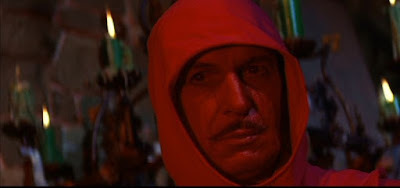
Although Corman worked on small budgets and had massive time constraints (AIP produced an average of nearly six films per year) he wasn’t a film director who looked down on the medium like many other Exploitation film directors did. In fact, with his distribution company New World, Corman imported many European films ranging from simply saleable to crucially classic (Bergman’s CRIES AND WHISPERS and Herzog’s FITZCARRALDO falling into the latter category). He was a fanatical film fan, consistently enamored by cinema and not afraid to utilize this affection when directing. A fine example would be the Bergman-esque touches on MASQUE OF THE RED DEATH (1964). Widely considered the best of the Cycle, it showcases several of AIP’s strongest links: the clash of the gothic and the psychedelic, captured brilliantly here in the cinematography of future director Nicholas Roeg; Vincent Price’s studied cruelty in the role of Prince Prospero – a truly ideal part for Price, who’s class blends with murderous nastiness that would’ve no doubt delighted Poe himself; and a solid script that spans more Poe than just MASQUE OF THE RED DEATH (the lesser-known Hop-Frog tale is prominent). Charles Beaumont (one of the three writers of the Twilight Zone and also this program’s PREMATURE BURIAL, 1962) and R. Wright Campbell (who wrote the superb Lon Chaney biopic MAN OF A THOUSAND FACES, 1957) collaborated on the script. Another writer, the legend Richard Matheson, penned the Cycle’s HOUSE OF USHER (1960), THE RAVEN (1963), TALES OF TERROR (1962), and PIT AND THE PENDULUM (1961) and the Robert Towne scripted TOMB OF LIGEA (1964) completes the Cycle entries in Anthology’s program, and the consistency of all these films is fascinating. Floyd Crosby was the cinematographer of most of these films and the look is always wonderful and a little insane. The creativity of his camerawork blends the stark almost documentary feel of someone at the forefront of his artistic awareness with some rather madcap camera wielding and positioning.
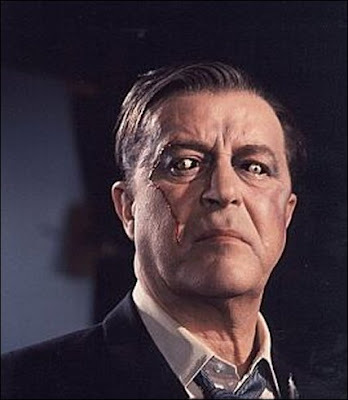
X: THE MAN WITH X-RAY EYES (1963) is a cool, bizarre flexing of Crosby’s massive talent, from peering thru flesh and organs to undressing an entire dance party, from hospitals to the seedy carnival circuit to the bright-hot desert chase at the film’s conclusion, Crosby displays lush perspective and color for all sorts of settings and tones. The beyond-impressive low budget effects really kick in when THE MAN (with X-Ray Eyes)’s vision starts to intensify further and he can see through things SO much that his vision is reduced to insanity-inducing splotches of colors, bone, and blinding light.
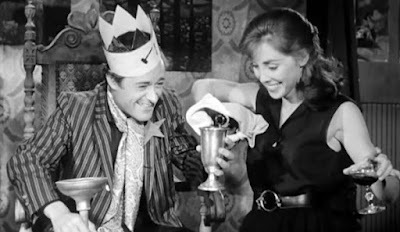
A BUCKET OF BLOOD (1959) is an invigorating achievement. It’s a small budget horror story fueled by excellent acting, madcap characters, and a brilliant script (by AIP staffer Charles B. Griffith). With A BUCKET OF BLOOD, something has been made out of nothing, an achievement Roger Corman accomplished many times over. The low budget film is cinema’s answer to the one act play, and like the one-act play there’s no reason that a low budget film can’t pack in just as much drama, excitement, emotion and intensity as its heavily funded contemporary.
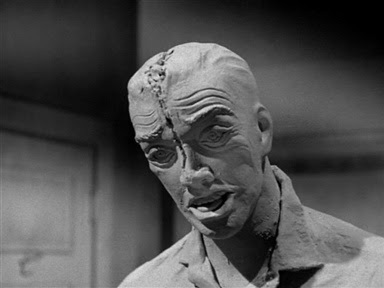
A BUCKET OF BLOOD is the story of Walter Paisley (Dick Miller’s best performance), an almost-retarded coffee shop bus boy who spends his time daydreaming and trying to fit in amongst the fancy artiste-types he serves coffee to. The setting is a mad and cinematic stereotype of a 1950’s beatnik dive, an even cartoonish backdrop. Poets and jazzbos, painters and bikers - everyone in Walter’s world looks down on him. Even those who like him treat him as an inferior – including the girl he loves. It doesn’t stop him from smiling though, or believing that he too could be an artist. One night in a fit of frustration, Walter accidentally kills his landlady’s cat. He takes some molding clay and does the only think he can think to do – hide the cat as a work of art, which of course rockets him to art-stardom.
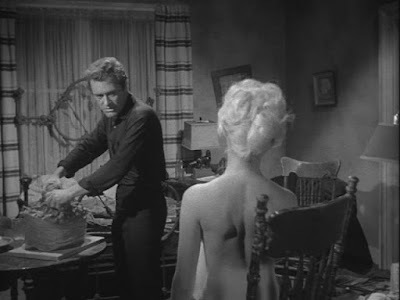
As Walter soaks in this undue fame he begins to distance himself with the ideals he had as a failure, and then things go wonderfully, bloodily wrong. It’s absolutely one of Corman’s finest moments. LITTLE SHOP OF HORRORS is A BUCKET OF BLOOD’s contemporary in many ways, and it’s also the only other film in this series that showcases what Corman was doing in the 1950’s. Even in it’s silliness and impoverished appearance the creativity does shine through in LITTLE SHOP OF HORRORS (the remake is great evidence) and almost shockingly it remains a unique, budget-less wonder.
All of Corman’s films for AIP were genre pictures except for one. Called the lone “serious” picture in the Corman/AIP canon, it performed poorly at the box-office and both were scared enough of not turning a profit again to ensure only genre outings from then out. And it’s a crime! This lone exception is THE INTRUDER (1962), a harrowing tale of a spineless racist instigator named Adam Cramer (played by William Shatner).
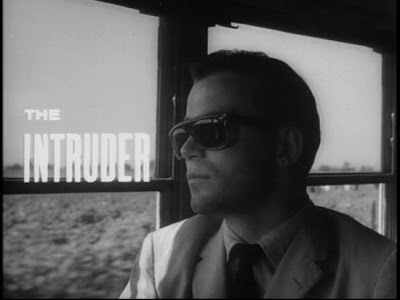
He arrives by bus to a small southern town soon after desegregation laws have passed that will integrate blacks and whites in American public schools. Using this as an opportunity to stir up the townspeople enough to create a Ku Klux Klan following, Cramer travels the south doing this “duty” for modern American white supremacy, getting the Klan going wherever he can. As ugly as it sounds, THE INTRUDER is perhaps the most attractive film of the whole set. It’s a brazen low-budget take on serious social concerns, and Corman, armed with a razor sharp script by Twilight Zone alum/AIP staff screenwriter Charles Beaumont (based on a his paperback), delivers a powerful piece of raw filmmaking that seems to inspire raving praise from all who cross it’s stark, black and white path (seriously, check out the User Comments on IMDB). THE INTRUDER spits in the face of average filmgoer expectation on all fronts – not only did Corman execute a perfect and lyrical parable proving the gross injustices of prejudice and fear, but William Shatner, whom laymen seem to consider a ham, shines so darkly as the sick-minded racist instigator that many a pea-brained Shatner-detractor are transformed after experiencing perhaps the finest role of his career. THE INTRUDER has chunks of painful realness that make it stand out from so many similarly themed but less effective films - in the beginning of the film the town’s newspaper editor is quite distasteful towards the idea of his daughter going to school with blacks, but wants to go along with the school integration because, as he says, “it’s the law”. It’s Shatner’s Cramer that incites the violence that convinces the same man that racism itself is an act of violence that only begets more violence. Charles Beaumont makes an appearance as the school principal, and many Corman AIP regulars flesh out the townsfolk.
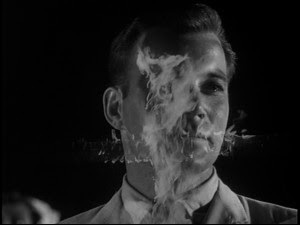
It was a rare batch of films, and it was an absolute treat to see them given appropriate status at Anthology Film Archives. Roger Corman gets a lot of credit for a lot of different things – he gets credit for being absurdly prolific and for setting some trends in the world of pop culture filmmaking. He gets credit for being a hack and stealing ideas from both art house and mainstream films, and he wrongly gets credit for simply being talentless. It’s quite welcome and all-to-rare to hear his name in association with the thing he really was passionate about – making good movies. It’s something he did quite a few times, and finally, thanks to Anthology, Roger Corman got some of the credit he deserves.



